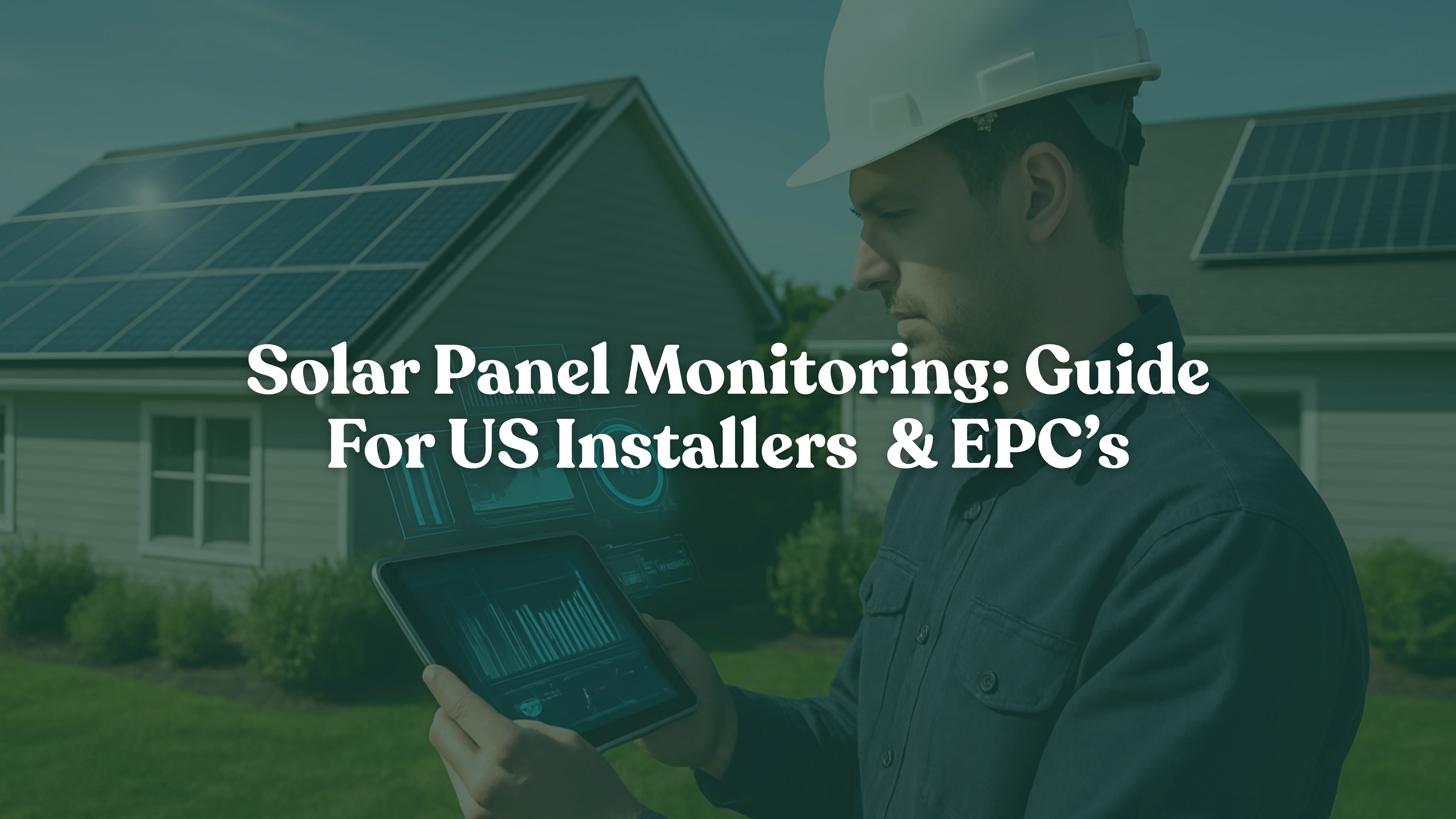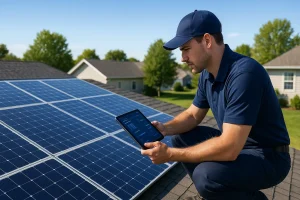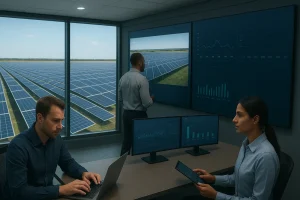How Do I Monitor My Solar Panel Performance and Energy Production?

Monitor Solar Panel Performance: The Complete Guide for US Installers and EPCs
Solar installers and EPCs face mounting pressure to deliver high-quality installations. Moreover, they must provide ongoing solar panel performance assurance that keeps customers satisfied. Additionally, systems must operate at peak efficiency consistently.
With over 3,000 PV systems installed at federal sites alone, solar panel performance monitoring has become crucial. Furthermore, the residential solar market expects 9% annual growth through 2030. Therefore, effective solar panel performance tracking represents the cornerstone of successful operations and maintenance strategies.
The solution lies in implementing comprehensive monitoring systems. These systems track solar panel performance and detect issues early. Consequently, they provide actionable insights that maximize both system output and customer satisfaction.
Why Solar Panel Performance Monitoring Matters for Your Business
Solar monitoring systems show real-time and historical solar production data. Additionally, they help identify problems before they cost significant money. Consequently, for US installers and EPCs, this translates directly to reduced service calls. Furthermore, it improves customer retention and enhances reputation in an increasingly competitive market.

The financial impact is significant. Solar installation and EPC services typically experience profit margins ranging from 10% to 20%. Therefore, every efficiency gain becomes crucial for business success. Additionally, when systems underperform due to undetected issues, both installers and customers lose money.
Customer Retention Through Proactive Monitoring
For instance, consider a lady who had a solar panel system installed. Her system remained switched off for over 3 months. Consequently, she missed out on hundreds of dollars in savings and feed-in tariff payments. This real-world example highlights why monitoring isn’t just about performance. Instead, it’s about protecting your customers’ investments and your business reputation.
Similarly, modern monitoring systems enable installers to receive automated system alerts. These alerts reach down to the module level. As a result, installers can provide more informed and efficient customer service. This proactive approach transforms potential customer complaints into opportunities. Therefore, it demonstrates exceptional service.
Types of Solar Monitoring Systems for Professional Installers
Manufacturer-Integrated Solutions
Leading inverter manufacturers like Enphase, SolarEdge, and Fronius offer built-in monitoring capabilities. For example, Enphase’s microinverters send data to the Enlighten cloud platform. Consequently, they provide module-level visibility for identifying underperforming panels.
Meanwhile, SolarEdge’s platform tracks systems and reduces O&M costs effectively. Therefore, it’s crucial for EPCs managing multiple installations.
Third-Party Monitoring Solutions
Similarly, SOLARMAN empowers installers and O&M service providers through cutting-edge technologies. These solutions provide universal compatibility across different inverter brands. Consequently, they offer flexibility for installers working with diverse equipment.
Advanced IoT-Based Monitoring
IoT devices gather performance data including energy generation, temperature, and voltage. Therefore, this technology enables predictive maintenance strategies. As a result, it significantly reduces operational costs.
Key Features Every Professional Monitoring System Needs

Real-Time Performance Data
Professional-grade monitoring systems must provide instant access to system performance metrics. Additionally, module-level monitoring helps optimize solar power production. Furthermore, alerts and notifications enable effective energy management.
Automated Alert Systems
Automatic service messages inform installers immediately about system errors. This enables instant error analysis via desktop or app. Consequently, immediate notifications are essential for maintaining customer satisfaction and system efficiency.
Fleet Management Capabilities
For EPCs managing multiple installations, centralized platforms provide detailed real-time fleet views. As a result, this reduces operational overhead and improves response times significantly.
Monitor Solar Panel Performance: Step-by-Step Implementation Guide
Phase 1: System Selection and Integration
First, choose monitoring solutions based on your typical installation portfolio. Therefore, consider standardizing on platforms that offer the best balance of features, cost, and customer usability.
Phase 2: Customer Education and Setup
Next, installers set the app up for customers and provide platform demonstrations. Subsequently, this initial education investment reduces support calls and improves customer satisfaction significantly.
Phase 3: Ongoing Monitoring and Maintenance
Finally, establish procedures for regular system health checks. This includes periodic equipment checking and monitoring production to ensure optimal performance consistently.
Maximizing Revenue Through Monitoring Services
Creating Recurring Revenue Streams
Notably, providing maintenance and operations services for solar systems offers ongoing revenue streams. These typically show profit margins ranging from 15% to 20%. Furthermore, monitoring services provide the foundation for these recurring revenue opportunities.
Predictive Maintenance Advantages
Similarly, IoT systems can predict potential failures or maintenance needs. They monitor parameters like panel temperature, voltage, and performance trends. Therefore, this capability allows installers to schedule maintenance proactively. Consequently, it reduces emergency service calls and improves customer relationships.
Value-Added Service Opportunities
Additionally, modern solar design software improves project quality and speed. Automated proposal tools and remote monitoring enhance these benefits. As a result, monitoring data can inform system expansion proposals. Furthermore, it enables energy optimization recommendations.
Technology Trends Shaping Solar Monitoring in 2025
AI-Powered Analytics
Currently, the integration of advanced technologies enhances installation efficiency and accuracy. These include artificial intelligence and drone surveying. Moreover, AI capabilities in monitoring systems are becoming standard features. Therefore, they’re essential for professional installations.
Mobile-First Platforms

Furthermore, mobile devices can transform into powerful operations hubs. They feature intuitive map-based views to navigate site activity. Additionally, they enable instant response to critical events. Consequently, mobile accessibility is crucial for field technicians and busy installers.
Integration with Smart Energy Systems
Additionally, IoT devices can connect and work with other smart energy systems. These include smart grids and energy management systems. Therefore, they optimize how solar energy is generated, used, and stored effectively.
Common Monitoring Challenges and Solutions
Connectivity Issues
First, ensure robust internet connectivity for monitoring systems. Specifically, solar monitoring systems connect to the internet through various methods. These include hardwiring, Wi-Fi, or cellular networks. Therefore, plan for backup connectivity options in remote installations.
Data Management and Analysis
Moreover, managers and technicians face challenges when monitoring solar panels. This includes dealing with complexities of collecting and analyzing large amounts of data. Consequently, choose platforms that provide actionable insights rather than raw data dumps.
Customer Adoption
Interestingly, solar panel monitoring becomes addictive when used correctly. It allows users to maximize savings and gain in-depth understanding of energy usage. Therefore, focus on educating customers about the benefits and ease of use.
ROI Analysis: The Business Case for Professional Monitoring

Reduced Service Calls
Notably, proactive monitoring significantly reduces emergency service calls. With modern live-feed monitoring systems, installers know what’s happening with systems accurately. Therefore, this enables remote troubleshooting before dispatching technicians.
Improved Customer Satisfaction
Furthermore, 24/7 remote monitoring continuously tracks solar panel performance. It detects issues in real-time and provides prompt maintenance. This ensures optimal energy production consistently. As a result, this level of service differentiates professional installers in the marketplace.
Enhanced System Performance
Finally, the best solar monitoring systems boost solar plants’ performance significantly. They feature advanced tools like solar saving calculators and performance charts. Additionally, they provide real-time monitoring capabilities.
Future-Proofing Your Monitoring Strategy
Scalability Considerations
Currently, digital project monitoring and modular mounting solutions represent emerging trends. Performance-linked service contracts are becoming standard practice. Therefore, choose monitoring platforms that can scale with your business growth effectively.
Integration Capabilities
Additionally, many manufacturers offer access to system data via APIs. These may be useful for custom-coded displays or smart home integration. Consequently, API access enables future integrations and custom solutions.
Conclusion: Partner with Energyscape Renewables for Comprehensive Solar Solutions
Effective solar panel monitoring isn’t just about tracking energy production. Instead, it’s about building lasting customer relationships and optimizing system performance. Additionally, it creates sustainable revenue streams for your business.

As the solar industry continues its rapid expansion, installers and EPCs who prioritize comprehensive monitoring solutions gain significant competitive advantages. Furthermore, with the residential solar market projected to grow 9% annually through 2030, monitoring becomes essential for business sustainability.
At Energyscape Renewables, we understand the unique challenges facing solar professionals. Our comprehensive approach combines cutting-edge monitoring technology with expert support services. Therefore, we help installers and EPCs deliver exceptional customer experiences while optimizing operational efficiency. Moreover, our solutions scale from residential installations to large commercial projects.
The future of solar success lies in proactive systems that monitor solar panel performance continuously. This includes predictive maintenance and data-driven decision making. By implementing comprehensive strategies to monitor solar panel performance, you’re building the foundation for sustained growth in the expanding renewable energy marketplace.
For additional insights into solar technology innovations and industry best practices, explore the comprehensive resources available at Sunscape Solar.

sjayakanth@energyscaperenewables.com